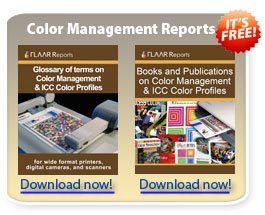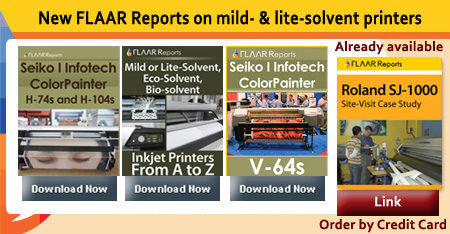Reviews of forthcoming.
Imagine a printer as relatively economical and more or less easy to use as an Encad, yet that will accept solvent based inks. And imagine if this printer lacked the crude splotchy print look which is typified by many older solvent-based printers with Xaar printheads.
 |
What if a company could produce the quality of a thermal printhead technology with the multiple benefits of a solvent-based pigmented ink?
You would be able to get photo-realistic quality yet with solvent-based pigmented inks for outdoor longevity.
Of course, at present such a printer has never successfully been produced. The output from most solvent-based printers is acceptable only if the viewing distance is 20 feet or greater. Some of the older grand format printers have to be viewed from billboard distance to be acceptable. This means that for wallpaper, none of the current solvent ink printers is acceptable. Unless of course you are the engineer who designed them; but to a normal viewer, inside a room, if output from a solvent ink printer is put side by side with the output of a Hewlett-Packard, ColorSpan, Epson or Roland, the differences are embarrassing. Solvent ink may last 3 to 5 years outdoors without lamination, but it does not survive 5 minutes of quality test in a reality check.
But technology is constantly advancing. If Epson can produce a piezo printhead which prints museum exhibit quality images, surely engineers at Xaar will eventually be able to get their dpi up. Eventually ink chemists will be able to get their pigment particle size down so it will fit through heads that produce acceptable quality.
At the upcoming trade shows, FLAAR will bring you news from all the solvent ink printers. So far the output from the cheaper solvent ink printers leaves much to be desired. But a few of the more expensive solvent ink printers are definitely improving.
Solvent inks work on economical substrates. No more overpriced inkjet media. No more need for lamination either.
| reviews of large format printers most appropriate for indoor signs, posters, banners, including POP |
| reviews of large format printers most appropriate for outdoor signs, posters, banners, billboards for outdoor use with solvent inks |
| for dye sublimation heat transfer onto T-shirts, other textiles, metal, wood, plastic, ceramics, metal and other treated surfaces |
| piezo vs thermal printhead inkjet printers: fact vs fiction, pros and cons of Epson-Roland-Mutoh-Mimaki vs Encad-HP-ColorSpan |
| media and inks for signs, posters, banners (for all printers, piezo as well as thermal inkjets) |
| quick-start help, list of the best RIPs; hints for what accessories you need; list of where you can get books and training on digital imaging color |
| We
do NOT cover: software headaches, repairs, obsolete
equipment, color matching or problems caused by
prior mistakes.
Our job is to save you from perhaps buying the wrong equipment by alerting you to advertising hype and help you avoid as many of the common pitfalls as possible. We even have a pithy report on "what to watch out for....guide for first-time buyers" when you suspect someone is exaggerating claims in the hopes of luring you into buying their printer. Includes frank assessment of exaggerated speed claims and gives lots of helpful tips and insight. Although we can't save you from negligence, lack of common sense and failure to read the instruction book, we can at least prepare you for the reality of digital imaging. We want to help you enjoy this experience and save you from the typical common mistakes of first time buyers. Some of the ads are so misleading that even pros are lured to buy these printers. So no matter what your experience level, you will find these reports informative. The FLAAR reports are written in a humerous style: how else can you review the claims and hype? |
| To receive your report just provide the information on the inquiry form (or just do it in your own words until we create a structured auto-response system). At present we answer all e-mails in person, yes, a live human being actually reads your e-mail, and will answer in 3 to 5 days. |
Most recently updated August 02, 2001.
 |